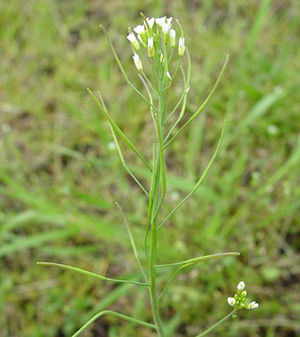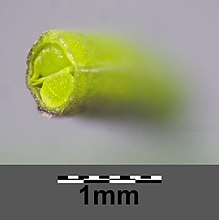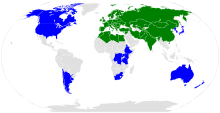Acker-Schmalwand
| Acker-Schmalwand | ||||||||||||
|---|---|---|---|---|---|---|---|---|---|---|---|---|

Field cress Arabidopsis thaliana |
||||||||||||
| Systematics | ||||||||||||
|
||||||||||||
| Scientific name | ||||||||||||
| Arabidopsis thaliana | ||||||||||||
| (L.) Heynh. |
The thale cress ( Arabidopsis thaliana ) is also cress or Gänserauke called and is a flowering plant in the family of cruciferous (Brassicaceae). It is relatively widespread in Eurasia and is classified as a " weed " in agriculture .
description
The Acker-Schmalwand is an inconspicuous, low, annual , herbaceous plant that reaches heights of up to 30 centimeters. The basal leaves are rosette and their stem is round. The leaves at the base are mostly serrated, the stem leaves, however, usually with entire margins.
The white flowers are 2 to 4 millimeters in size. The plant has pods that are 10 to 20 millimeters long.
The number of chromosomes is 2n = 10.
distribution
The arable cress is of course widespread in the temperate climates of the northern hemisphere of the Old World . The total natural range extends from North Africa to the Indian subcontinent and from all of Europe via Siberia to eastern Asia. In many parts of the world with a moderate climate, the arable cress is a neophyte .
Locations and socialization
The narrow wall of arable fields typically grows in the accompanying field, preferably on open sandy soils or in loose, poor grassland. In Central Europe it is a so-called apophyte , as the species originally native to dry forest border locations changed to anthropogenic locations when forests were cleared by humans in Central Europe about 7000 years ago to make space for fields. These locations were more open than most of the natural ones and they were regularly disturbed and thus offered the Acker-Schmalwand optimal living conditions. The Acker-Schmalwand is a character type of the order Sedo-Scleranthetalia, but also occurs in societies of the Aperion association or the Digitario-Setarienion sub-association.
ecology
The Acker-Schmalwand is annual, winter annual (up to two years). It is rooted up to 40 centimeters deep. The flowers are small "nectar-bearing funnel flowers". Because of their inconspicuousness, the insect visit is only sparse, instead 99 percent self-pollination occurs. Nonetheless, cross-pollination by solitary bees, two-winged bees and bladder feet is also significant. The plant blooms from April to May, but as a typical field weed can bloom even later.
The pods are elongated after flowering and contain 20 to 30 long-lived seeds as light germs. Since the seed coat produces short adhesive threads when wet, the seeds can spread and spread unintentionally by humans with soil. The pods themselves are wind spreaders. The fruit ripening begins in June.
Systematics and research history
The Acker-Schmalwand was first described in the 16th century by Johannes Thal , whose name it bears in the specific epithet . He found it in the Harz Mountains and named it Pilosella siliquosa . Since then this species has been renamed several times. Several varieties have been described, but none of them are currently assigned taxonomic value.
The Basionym Arabis thaliana L. was first published by Carl von Linné in Species Plantarum , whereby the part of the name Arabis wrongly assigned the plant to the goose cress (Arabis). Gustav Heynhold established the genus Arabidopsis with this species as a type species under the name Arabidopsis thaliana , which is valid today ( Arabidopsis = "reminding of the Arabis"). Further synonyms for Arabidopsis thaliana (L.) Heynh. are: Arabidopsis thaliana var. apetala O.E. Schulz , Arabidopsis thaliana var. brachycarpa Andr. , Arabidopsis thaliana var. Genuina Briq. , Arabis pubicalyx Miq. , Arabis zeyheriana Turcz. , Conringia thaliana Rchb. , Crucifera thaliana (L.) EHL Krause , Hesperis thaliana (L.) Kuntze , Phryne gesneri Bubani , Sisymbrium bellidifolium Poir. , Sisymbrium thalianum (L.) Gaudin , Sisymbrium thalianum (L.) J.Gay & Monnard , Stenophragma thalianum (L.) Čelak.
As a model organism in biology
The field cress was established as a model organism in genetics as early as the 1940s (“the fruit fly of botany”). In 1943 Friedrich Laibach described the possibility of using Arabidopsis as a model plant. The advantages that the plant offers are for example:
- It has a relatively small, diploid genome of 125 Mbp , which sequencing was completed in 2000. The genome consists mainly of coding DNA sequences.
- It only has five pairs of chromosomes (2n = 10), of which detailed maps have already been made.
- It has a short generation cycle of just eight weeks (from seed germination to seed maturity).
- It is easy to cultivate in a relatively small space.
- The ability to self-isolate simplifies the production of homozygous plants.
- Many mutants are already known that can be ordered in the stock centers . Their long-term storage as seeds is extremely easy.
- Genetic manipulations can be performed, e.g. B. Transformation by Agrobacterium tumefaciens .
- Arabidopsis represents the physiology of higher plants well (example light physiology).
Web links
- Acker-Schmalwand in the National Center for Biotechnology Information (NCBI)
- Acker-Schmalwand. In: FloraWeb.de.
- Distribution map for Germany. In: Floraweb .
- Arabidopsis thaliana (L.) Heynh. In: Info Flora , the national data and information center for Swiss flora .
- Distribution in the northern hemisphere from: Eric Hultén, Magnus Fries: Atlas of North European vascular plants. 1986, ISBN 3-87429-263-0 at Den virtuella floran. (swed.)
- Thomas Meyer: Data sheet with identification key and photos at Flora-de: Flora von Deutschland (old name of the website: Flowers in Swabia )
- The Arabidopsis Information Resource (TAIR) - information on the genome, genes and mutants.
- The Arabidopsis Book - Constantly updated internet textbook about Arabidopsis .
literature
- Ihsan A. Al-Shehbaz: Arabidopsis. In: Flora of North America Editorial Committee (Ed.): Flora of North America North of Mexico . Volume 7: Magnoliophyta: Salicaceae to Brassicaceae . Oxford University Press, New York / Oxford a. a. 2010, ISBN 978-0-19-531822-7 , Arabidopsis thaliana , p. 450 (English, online ). (Sections Description, Distribution and Systematics)
- Tai-yien Cheo, Lianli Lu, Guang Yang, Ihsan Al-Shehbaz, Vladimir Dorofeev: Brassicaceae. In: Wu Zheng-yi, Peter H. Raven (Ed.): Flora of China . Volume 8: Brassicaceae through Saxifragaceae . Science Press / Missouri Botanical Garden Press, Beijing / St. Louis 2001, ISBN 0-915279-93-2 , Arabidopsis thaliana , p. 120 (English, online ). (Section description)
- Saiyad Masudal Hasan Jafri: Flora of West Pakistan 55: Brassicaceae . Stewart Herbarium, Gordon College (et al.), Rawalpindi 1973, p. 268 ( online ). (Section description)
Individual evidence
- ↑ a b c Erich Oberdorfer : Plant-sociological excursion flora for Germany and neighboring areas . With the collaboration of Angelika Schwabe and Theo Müller. 8th, heavily revised and expanded edition. Eugen Ulmer, Stuttgart (Hohenheim) 2001, ISBN 3-8001-3131-5 , pp. 476 .
- ↑ a b c Arabidopsis thaliana in the Germplasm Resources Information Network (GRIN), USDA , ARS , National Genetic Resources Program. National Germplasm Resources Laboratory, Beltsville, Maryland.
- ↑ a b Ruprecht Düll , Herfried Kutzelnigg : Pocket dictionary of the plants of Germany and neighboring countries. The most common Central European species in portrait . 7th, corrected and enlarged edition. Quelle & Meyer, Wiebelsheim 2011, ISBN 978-3-494-01424-1 , p. 103-104 .
- ↑ Carl von Linné: Species Plantarum. Volume 2, Lars Salvius, Stockholm 1753, p. 665 ( digitized version ).
- ^ Friedrich Holl, Gustav Heynhold: Flora von Sachsen. Description of the wild and generally cultivated plants in the Kingdom of Saxony, the Duchy of Saxony, Prussian Antheils, the Grand Ducal and Ducal Saxon Lands of the Ernestine Line, the Ducal Anhalt, Princely Schwarzburg and Princely Reussian Lands, with special consideration of their use in pharmacy, technology and deconomy, etc. . Volume 1, no. 2, Justus Naumann, Dresden 1842, p 538 (online) .
- ↑ Sisymbrium loeselii at Tropicos.org. Missouri Botanical Garden, St. Louis
- ^ The Arabidopsis Genome Initiative: Analysis of the genome sequence of the flowering plant Arabidopsis thaliana. In: Nature. Volume 408, No. 6814, December 14, 2000, pp. 796-815, doi: 10.1038 / 35048692 .
- ↑ AM Lloyd, AR Barnason, SG Rogers, MC Byrne, RT Fraley: Transformation of Arabidopsis thaliana with Agrobacterium tumefaciens . In: Science (New York, NY) . tape 234 , no. 4775 , October 24, 1986, ISSN 0036-8075 , p. 464-466 , doi : 10.1126 / science.234.4775.464 , PMID 17792019 .






